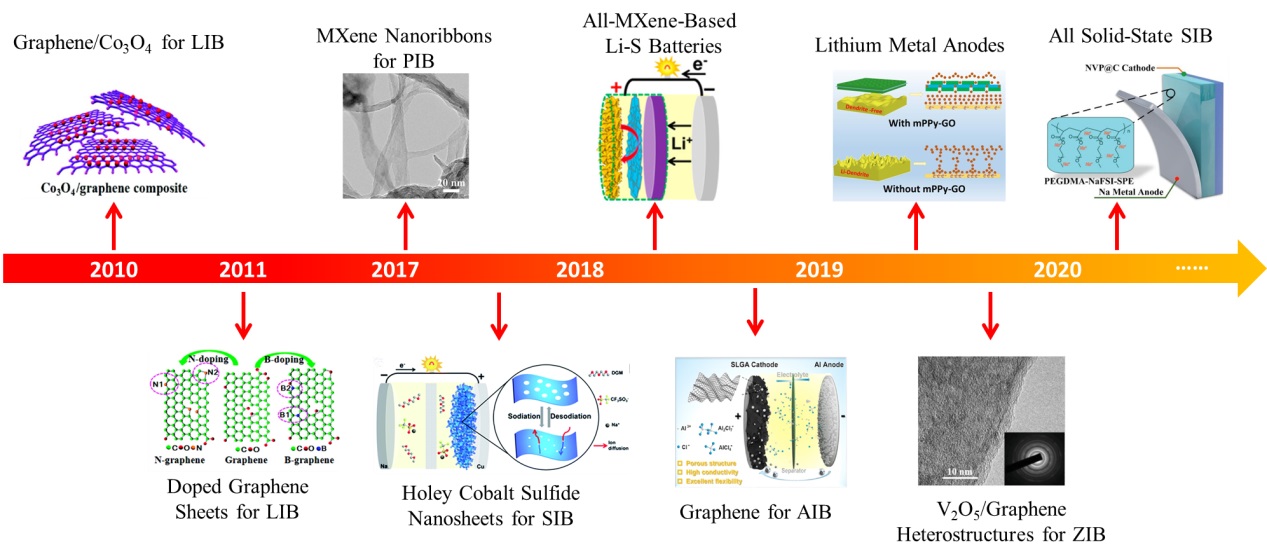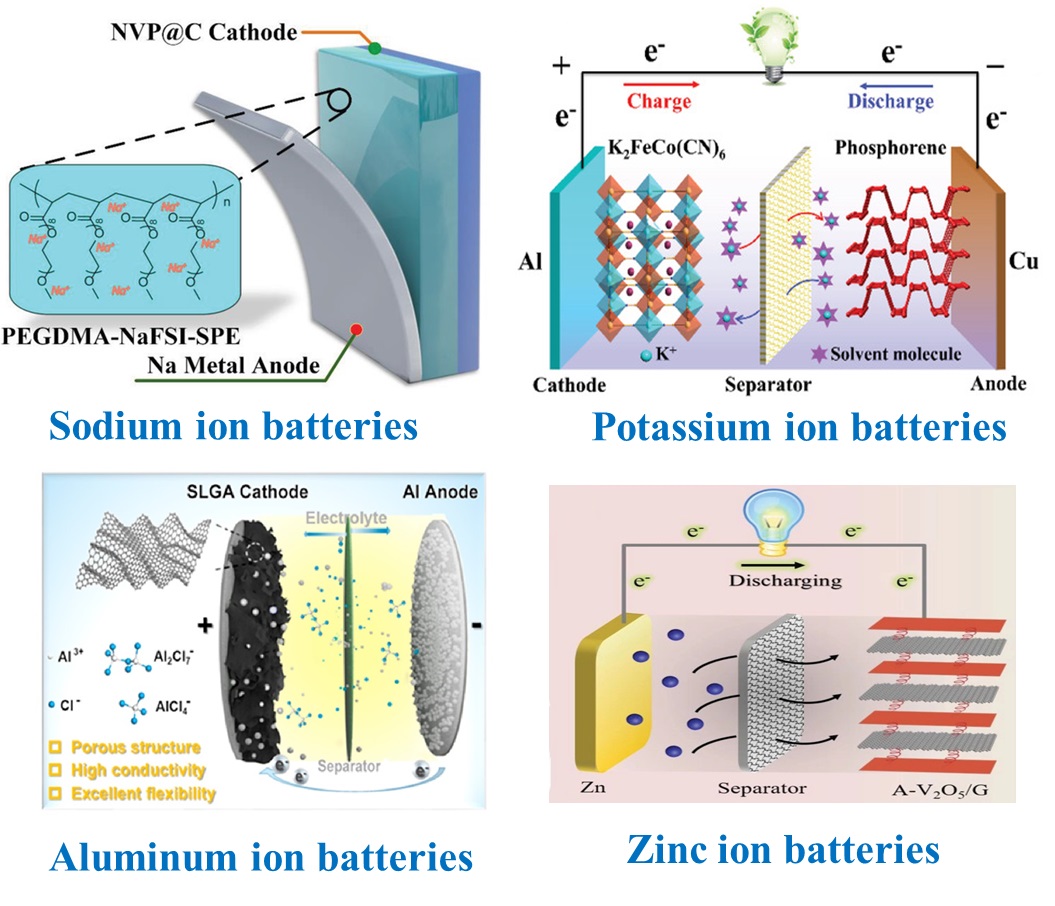The consistent concerns on fast consumption of fossil fuels, global warming, environmental pollution, and ever-increasing number of vehicles have greatly accelerated the development of advanced energy batteries with superior performance to the commercially available batteries. However, the critical components of advanced battery systems are the materials science aspects that implement novel unique materials science concepts, e.g., innovative electrodes and electrolyte, and advanced methodologies to describe the major different features that control the behavior of advanced electrochemical storage systems. Graphene and 2D materials with unprecedented properties will offer novel chances to create new-type advanced energy batteries with great potential to challenge the state-of-the-art performance limits of traditional devices and beyond.

High-Energy Lithium Batteries:
Lithium-ion battery is a primary secondary battery with high energy density used in the market. However, further updating its energy density is currently becoming an urgent requirement especially raised in the high energy-oriented applications of electrical vehicles. The as-designed graphene and related 2D energy materials will provide many excited opportunities to construct high-capacity cathode (e.g., LiFePO4, LiMn2O4, LiCoO2, LiNiMnCoO2) and anode materials of lithium-ion batteries (e.g., Li4Ti5O12, Si) with high energy densities and enhanced cycling stability through the exact designs of micro-nano structures, the strategies of surface coating, controlled synthesis of these novel materials and assembly of full devices, particularly, graphene-based batteries. To achieve high-energy applications, the future development of lithium metal secondary batteries with high energy densities, such as lithium-oxide batteries, lithium-sulfur battery and lithium-air battery based on as-designed 2D materials are also becoming very promising yet urgent.

New-Type Batteries:
Present lithium-ion batteries show drawbacks of limited lithium resources, low theoretical capacities, and relatively high costs. To overcome these obstacles and meet different future energy-related applications, new-type safe advanced batteries, like Sodium/Potassium/Aluminum/Zinc ion batteries, all-solid-state batteries and 3D batteries, are becoming one of the most promising development directions in these cutting-edge research field of graphene and 2D materials. A particular emphasis is placed on the recent trends of new 2D materials, concepts, and techniques of battery research and development, including novel electrodes materials of metal hydrides, lithium-carbon alloys, intermetallic alloys, lithium-transition metal oxides and polymeric components; electrolytes materials of crystalline and amorphous solid electrolytes, as well as organic solvent electrolytes; developing new manufacture technologies and device architectures.

Supercapacitors:
Supercapacitors (electrochemical capacitors, ultracapacitors) possess the huge ability to store superior power density that is at least one order of magnitude larger than lithium-ion batteries, and an impressive energy density that is two orders of magnitude higher than the traditional electrolytic capacitors. We have explored a wide range of synthetic graphene, heteroatom-doped graphene and graphene-like 2D materials for new-generation electric double layer capacitors, pseudocapacitors, and hybrid supercapacitors. Recently, we are focusing on the construction of hybrid ion capacitors composed of a high-capacity battery-type electrode and a high-rate capacitor-type electrode. Taking advantages of different charge storage mechanisms, hybrid ion capacitors hold the potential to bridge the gap of energy and power densities between batteries and supercapacitors and are regarded as a new-type energy storage device to achieve “Double High” supercapacitors. The diverse roles of graphene and 2D materials in hybrid ion capacitors are illuminated as (i) promising electrochemical active materials, (ii) ultrathin conductive and flexible supports or coatings for hybridization with other active materials, and (iii) 2D functional building blocks for assembling macroscopic hierarchical 3D frameworks with high electrical conductivity and rapid ion transport.

Selected Publications
Two-Dimensional Mesoporous Polypyrrole-Graphene Oxide Heterostructure as Dual-Functional Ion Redistributor for Dendrite-free Lithium Metal Anodes. Angewandte Chemie, 2020, 59, 2-9.
2D Amorphous V2O5/Graphene Heterostructures for High-Safe Aqueous Zn-Ion Batteries with Unprecedented Capacity and Ultrahigh Rate Capability. Advanced Energy Materials, 2020, 2000081.
Molecular-Level Design of Pyrrhotite Electrocatalyst Decorated Hierarchical Porous Carbon Spheres as Nanoreactors for Lithium-Sulfur Batteries. Advanced Energy Materials, 2020, 10, 2000651.
Graphene Aerogel Derived Compact Films for Ultrafast and High-Capacity Aluminum Ion Batteries. Energy Storage Materials, 2019, 23, 664-669.
Free-Standing Integrated Cathode Derived from 3D Graphene/Carbon Nanotube Aerogels Serving as Binder-Free Sulfur Host and Interlayer for Ultrahigh Volumetric-Energy-Density Lithium-Sulfur Batteries. Nano Energy, 2019, 60, 743-751
All-MXene-Based Integrated Electrode Constructed by Ti3C2 Nanoribbon Framework Host and Nanosheet Interlayer for High-Energy-Density Li-S Batteries. ACS Nano 2018, 12, 2381.
Ti3C2 MXene-Derived Sodium/Potassium Titanate Nanoribbons for High-Performance Sodium/Potassium Ion Batteries with Enhanced Capacities. ACS Nano 2017, 11, 4972-4800.
Alkalized Ti3C2 MXene Nanoribbons with Expanded Interlayer Spacing for High-Capacity Sodium and Potassium Ion Batteries. Nano Energy 2017, 40, 1-8.
Graphene Anchored with Co3O4 Nanoparticles as Anode of Lithium Ion Batteries with Enhanced Reversible Capacity and Cyclic Performance. Acs Nano 2010, 4, 3187-3194.
Anchoring Hydrous RuO2 on Graphene Sheets for High-Performance Electrochemical Capacitors. Advanced Functional Materials 2010, 20, 3595-3602.